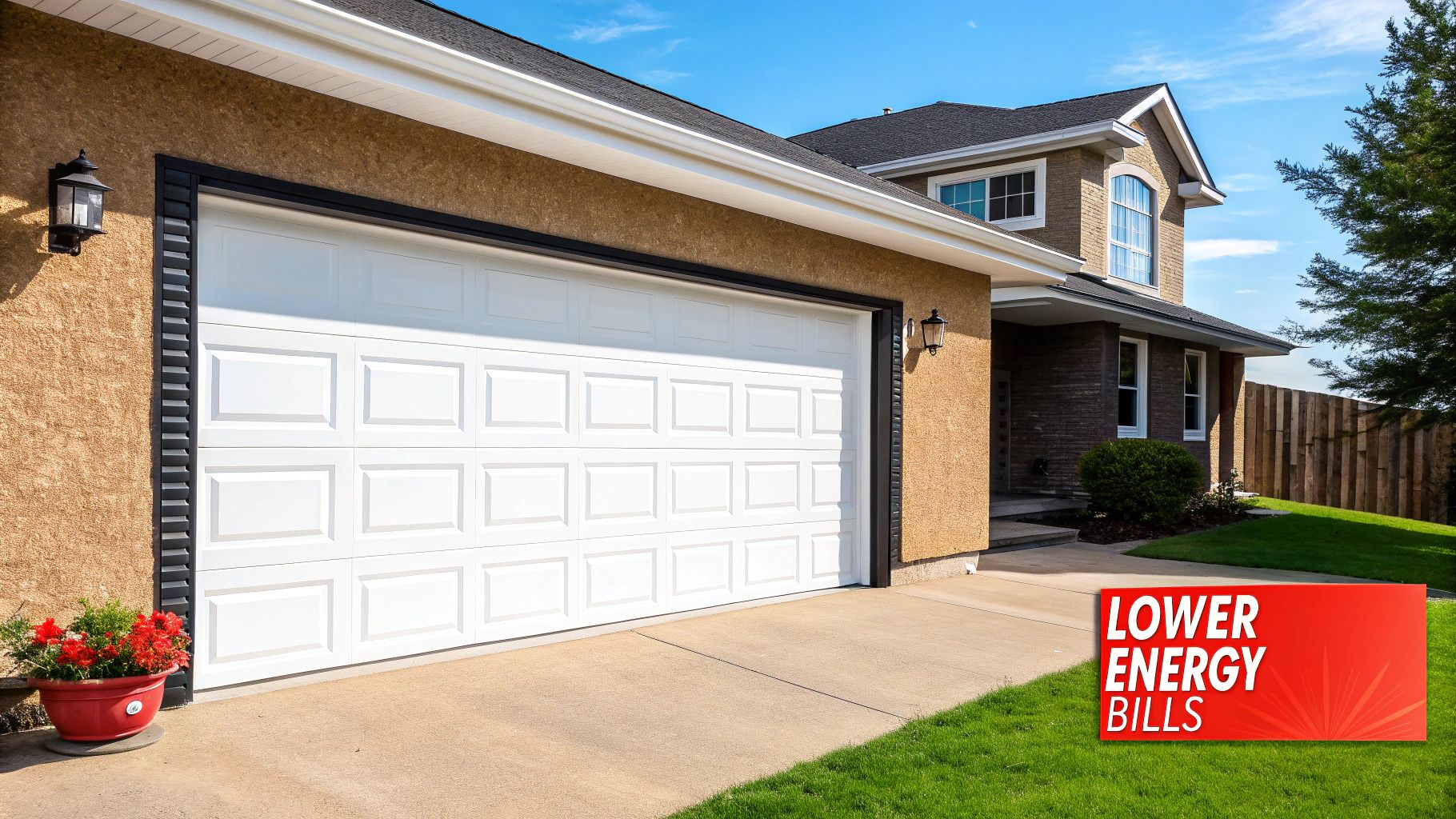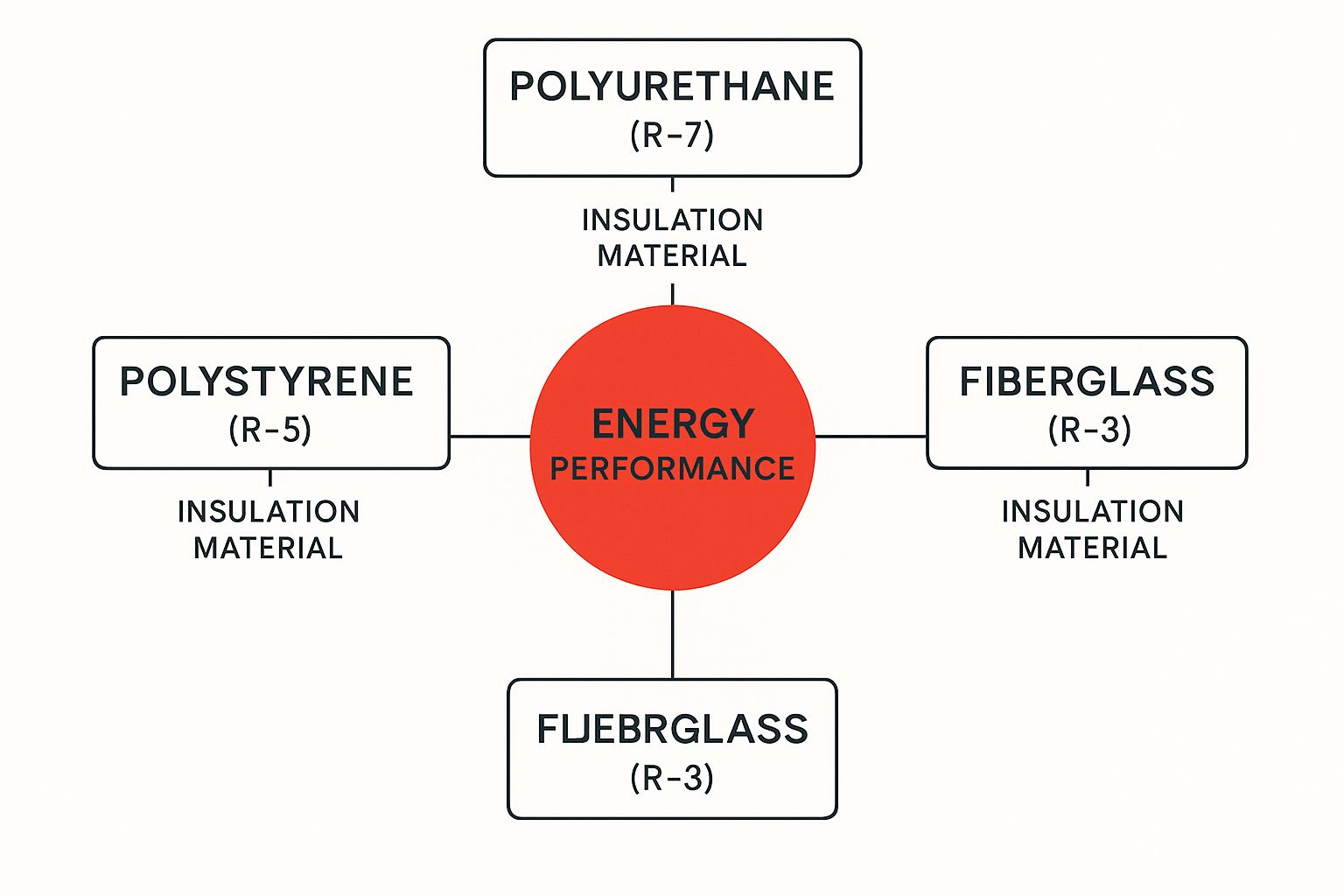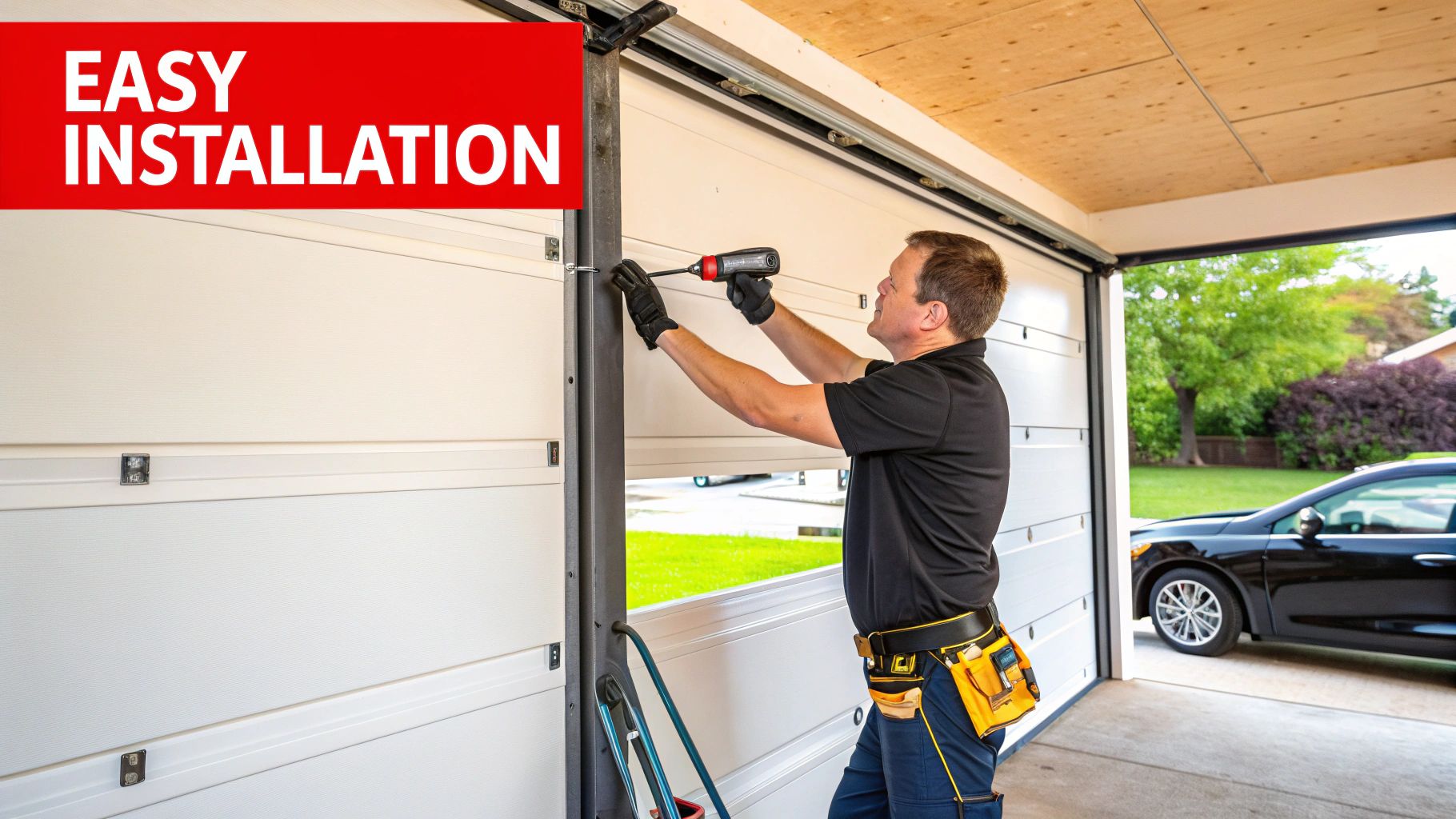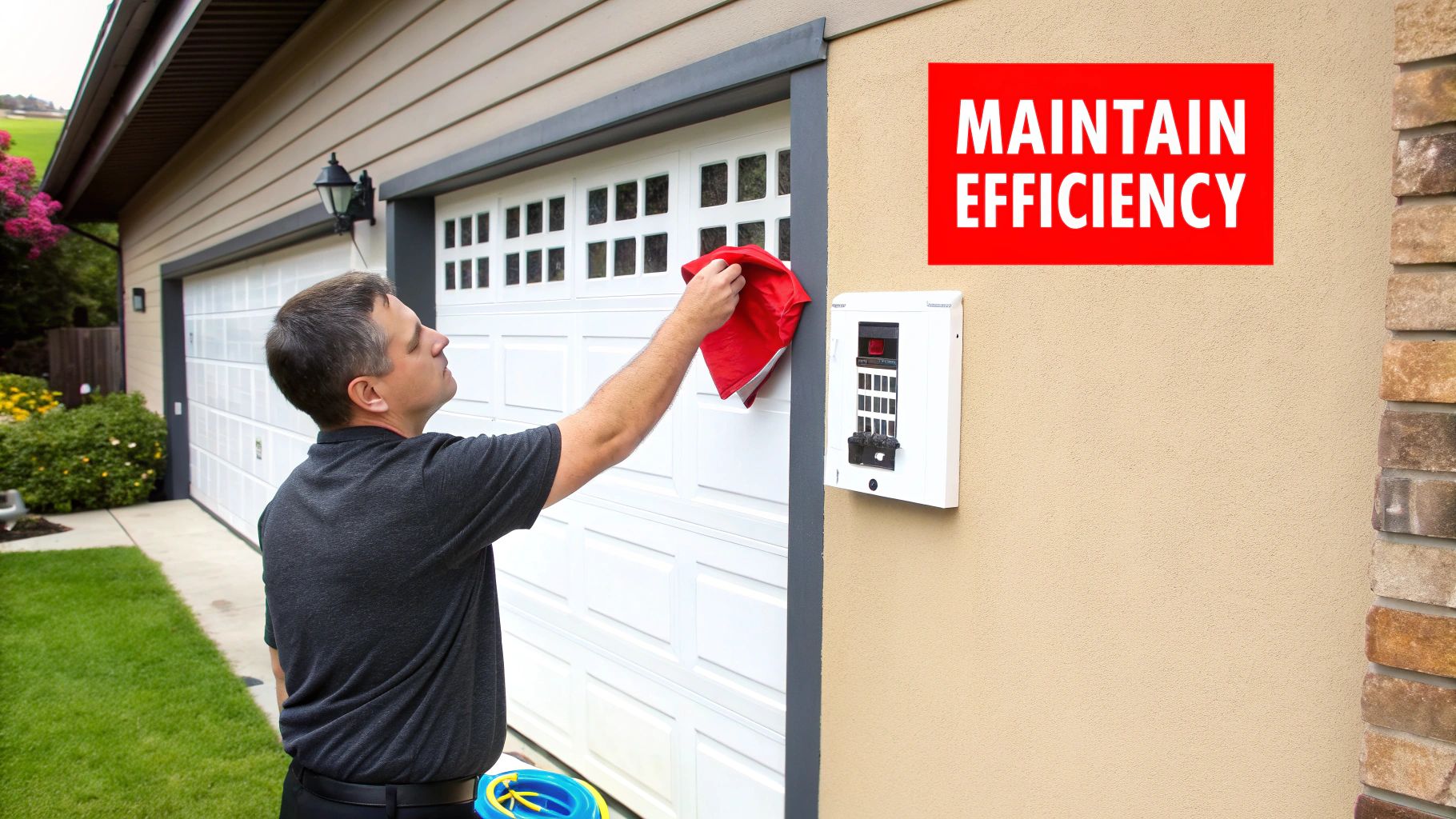An energy-efficient garage door is far more than just a way to get your car in and out. Think of it as a thermal shield for your entire home or commercial building. These doors are specifically built with advanced insulation and tight weather sealing to stop unwanted heat transfer.
The result? Your garage stays cooler in the scorching Texas summer and warmer during an Oklahoma cold snap. According to industry data, this can translate into significant reductions in energy consumption and, more importantly, your monthly utility bills.
How Your Uninsulated Garage Door Wastes Money

Imagine leaving a giant window wide open, 24/7, all year long. That’s the practical effect of an uninsulated garage door. As the single largest moving part of your property, it’s often the biggest vulnerability in your building's thermal envelope, letting your heating and cooling dollars drift away.
This problem is amplified in the demanding climates of Texas and Oklahoma. Between blistering summer heat and sudden winter freezes, our HVAC systems are constantly under pressure. An old, flimsy door allows radiant heat to bake your garage, and that heat inevitably seeps into your home, forcing your AC to work harder and consume more electricity.
The True Impact on Your Property
The consequences go beyond high energy bills. An uninsulated door can make your garage unusable for months—too hot for a workshop in July, too cold for a home gym in January. For businesses, this temperature volatility can damage sensitive inventory or violate OSHA standards for a comfortable work environment. A strategic upgrade to one of our modern garage doors can reclaim this space and make it a functional part of your property again.
Homeowners and businesses are catching on. The global insulated garage doors market was valued at $4.5 billion in 2023 and is projected to climb to $7.8 billion by 2032. This isn't just a trend; it's a major shift as property owners recognize the long-term ROI of energy-conscious upgrades.
Actionable Tip: An energy-efficient garage door isn't just an upgrade; it’s a capital investment in your property's comfort, value, and long-term operational costs. It actively works to reduce the burden on your HVAC system from day one.
More Than Just a Door
A high-performance door delivers a host of tangible benefits:
- Improved Comfort: It helps stabilize temperatures not just in the garage, but in adjacent rooms. Say goodbye to drafty kitchens or freezing bonus rooms above the garage.
- Reduced HVAC Strain: By creating a robust thermal barrier, the door eases the workload on your heating and cooling system, potentially extending its operational lifespan.
- Increased Property Value: A modern, insulated door boosts curb appeal and is a highly attractive feature for potential home buyers, often recouping over 100% of its cost at resale.
- Noise Reduction: The dense insulation core is also fantastic at dampening sound, muffling street noise and creating a quieter interior environment.
Ultimately, this single upgrade provides a powerful, lasting solution. Professional garage door installation is crucial to ensure a perfect fit and seal, guaranteeing you receive every one of these benefits right from the start.
Decoding R-Value and Insulation Technology
When researching energy-efficient garage doors, the most important metric you'll encounter is R-value. Think of it as the door's thermal armor rating. It’s a standardized measurement of how well the door resists heat flow.
A higher R-value means better insulation. It's what keeps the brutal Texas summer heat from turning your garage into an oven and stops precious warmth from leaking out during an Oklahoma cold snap. Understanding this number is the first step, and it's a principle you see across the board with the benefits of insulated home components, like roofs.
The Science Behind the Numbers
A garage door’s R-value is determined by its materials, thickness, and construction. For homeowners and business owners, this value is the most reliable way to compare thermal performance. A standard, non-insulated steel door barely registers, with an R-value close to R-0. It offers virtually no protection from the elements.
In contrast, a modern, multi-layer door with high-quality insulation can achieve an R-value of 18 or higher. That's the difference between a simple parking space and a comfortable, usable extension of your home or business.
Polystyrene vs. Polyurethane Insulation
The two dominant insulation materials in the garage door industry are Polystyrene and Polyurethane. They both get the job done, but their performance and application differ significantly.
Polystyrene (EPS) is a rigid foam board, similar to the material in a disposable coffee cup. Manufacturers cut it to size and fit it between the door's steel panels. It’s a solid, cost-effective choice that provides good insulation, making it a popular option for residential projects.
Polyurethane, often marketed under brand names like IntelliCore®, is a high-performance thermoset polymer. It’s injected between the steel panels as a liquid, then expands to fill every single gap and crevice. This process creates an incredibly dense and solid thermal barrier, delivering a much higher R-value per inch compared to Polystyrene.
This infographic gives a great visual breakdown of how these materials stack up.

As you can see, polyurethane is the clear winner for maximum thermal performance.
For a more detailed look, this table breaks down the key differences between these two leading insulators, helping you decide which is the right fit for your property.
Polystyrene vs Polyurethane Insulation A Head-to-Head Comparison
| Feature | Polystyrene (EPS) | Polyurethane (IntelliCore®) |
|---|---|---|
| Thermal Performance (R-Value) | Good (Approx. R-3 to R-5 per inch) | Excellent (Approx. R-6.5 to R-7.5 per inch) |
| Durability & Strength | Provides some rigidity to the door. | Injected foam bonds to the steel, adding significant structural integrity. |
| Moisture Resistance | Good resistance to moisture absorption. | Excellent; the dense, closed-cell structure is highly resistant to water. |
| Cost | More budget-friendly initial investment. | Higher initial cost but provides greater long-term energy savings. |
| Best For | Detached garages, budget-conscious residential projects. | Attached garages, climate-controlled spaces, commercial facilities. |
Actionable Tip: While Polystyrene offers a great value, Polyurethane provides superior insulation and strength, making it the better long-term investment for anyone serious about energy efficiency and durability.
Multi-Layer Construction: The Key to Strength
Great insulation requires a robust structure. The best energy-efficient garage doors use a multi-layer "sandwich" design to maximize performance.
- Single-Layer: A single sheet of steel. This is the most basic and least insulated option.
- Double-Layer: A steel front panel with a layer of Polystyrene insulation bonded to the back. A good step up.
- Triple-Layer: The premium configuration. It features a steel front, a thick core of insulation (either type), and a protective steel backer.
Industry Benchmark: A triple-layer door with polyurethane insulation is the gold standard for energy efficiency. It not only delivers the highest R-value but also creates a door that's significantly stronger, quieter, and more resistant to dents.
This robust build is especially critical for commercial settings where doors face heavy use and thermal control is essential for daily operations.
R-Value Recommendations for Texas and Oklahoma
So, what R-value do you actually need? It boils down to your garage's function and location.
- Detached Garages: For a standalone garage, an R-value between R-6 and R-9 is usually sufficient. It’s enough to moderate extreme temperatures and protect belongings.
- Attached Garages: This is where insulation truly pays off. We strongly recommend an R-value of R-12 to R-18+. The garage door acts as a buffer, protecting your main living space from heat transfer and taking a major load off your HVAC system.
- Climate-Controlled Garages & Commercial Spaces: If your garage is a workshop, home gym, or a commercial facility needing stable temperatures, go for the highest R-value you can get (R-18+). It’s a worthwhile investment in both comfort and operational costs.
The Hidden Features of an Airtight Garage

A high R-value is crucial, but it's only one piece of the puzzle. Real energy efficiency comes from a complete system engineered to seal out the elements. This is where you find the unsung heroes of garage door performance—the features that create a truly airtight barrier against the harsh Texas and Oklahoma weather.
Think of it like a high-end cooler. The thick insulated walls are vital, but if the lid doesn’t have a tight gasket, all the cold air escapes. Your garage door is no different; without a comprehensive sealing system, even the best insulation can't perform optimally.
The Power of a Perfect Seal
The biggest energy leaks often occur in the tiny gaps around the door's perimeter. A properly designed energy-efficient door addresses this with a system of robust weather seals that work in concert to stop drafts, moisture, pests, and dust.
These aren't just simple strips of rubber; they are engineered components designed to create a continuous barrier.
- Bottom Seal: Your first line of defense. A thick, flexible gasket along the bottom edge compresses against the garage floor to form a tight seal, conforming to minor imperfections in the concrete.
- Perimeter Seals: Vinyl or rubber weatherstripping, often called "stops," is installed along the top and sides of the door jamb. When closed, the door presses firmly against these stops, effectively locking out drafts.
- Between-Section Seals: On higher-quality doors, you’ll even find seals between each individual panel. This detail prevents air infiltration through the horizontal joints, significantly boosting the door's overall thermal performance.
When all these seals work together, you get a space that's not just more energy-efficient, but also cleaner and quieter. You can explore these essential parts and other upgrades in our guide to garage door accessories.
Understanding the Thermal Break
Even with the best insulation, heat travels along the path of least resistance. On a typical steel garage door, the inner and outer metal panels can touch. This direct contact allows the outside temperature to conduct straight through the door frame—a problem known as thermal bridging.
Industry Terminology: A thermal break is a design feature that separates the interior and exterior steel skins of a garage door. It uses a material that resists heat transfer to create a gap, preventing the outside temperature from "bridging" to the inside.
By breaking this conductive path, a thermal break dramatically improves the door's insulating power. It’s a key feature separating high-performance doors from standard ones, ensuring the R-value of the insulation isn't compromised by the door's own construction.
Insulated Windows Without Compromise
Many property owners hesitate to add windows to their garage doors, fearing they'll sacrifice energy efficiency for natural light. With modern technology, you don't have to make that choice.
The secret is insulated glass, which typically means a double-pane or even triple-pane design.
- Double-Pane Glass: This design uses two panes of glass separated by a sealed space filled with air or an inert gas like argon. The gas pocket acts as a poor conductor of heat, dramatically reducing temperature transfer.
- Low-E Coatings: A microscopic, transparent metallic coating can be applied to the glass to reflect infrared heat. In summer, it helps reflect the sun's heat out of your garage. In winter, it reflects your garage's own heat back in.
Actionable Tip: By choosing windows with these features, you can let sunlight stream in while keeping the weather out. This gives you a brighter, more usable space—whether for a workshop in Abilene or a commercial showroom in Denison—without negating your investment in an energy-efficient door.
Calculating the ROI of Your New Garage Door
An energy-efficient garage door is a smart financial move. While immediate benefits like improved curb appeal and comfort are valuable, the real story is in the numbers. This is an upgrade that genuinely pays for itself over time, a compelling reason for property owners in Texas and Oklahoma to invest.
The most direct return is on your monthly utility bills. The U.S. Department of Energy notes that a well-insulated and properly sealed garage door can significantly reduce heating and cooling costs.
A Practical Savings Calculation
Let's break down the real-world impact.
Your standard, uninsulated steel door is a thermal liability. It offers virtually no resistance to the elements, forcing your HVAC system to work overtime—especially if a living space is adjacent to or above the garage.
Now, replace that with a modern triple-layer door with high-quality polyurethane insulation (an R-value of 16 or higher). You've just installed a formidable thermal barrier. This one upgrade can slash energy loss through your garage by more than 70%. For a homeowner in Lawton or a business in Wichita Falls, that could easily mean saving $200 to $400 annually, sometimes more, depending on your property and HVAC system.
For a commercial building like a climate-controlled warehouse or auto shop, the savings are scaled up dramatically. Insulating large overhead doors can save thousands of dollars per year in operational costs, making it a clear-cut business decision.
Boosting Curb Appeal and Resale Value
The financial benefits don't stop with energy bills. A new garage door is one of the most effective exterior upgrades, consistently delivering one of the highest returns on investment. In fact, Remodeling Magazine's Cost vs. Value Report often shows homeowners recouping over 100% of the cost at resale.
From a buyer's perspective, a sharp, modern, energy-efficient door signals that the property is well-maintained and cost-effective to run. It's a first impression that adds tangible value. Achieving that value depends on flawless performance, which is why professional garage door installation is non-negotiable.
Unlocking Financial Incentives
To further improve the ROI, federal and local programs are often available to help offset the cost.
- Energy Efficient Home Improvement Credit: This federal tax credit can cover a portion of the cost for qualifying energy-efficient upgrades. Insulated garage doors that meet specific standards are often included.
- Local Utility Rebates: Many electric companies in Texas and Oklahoma offer cash rebates to customers who install energy-saving products.
Actionable Tip: Always check with your local utility provider and a tax professional to see what incentives are available. These programs can significantly reduce the upfront cost, allowing your new door to start paying for itself even faster.
When you sum up the tax credits, utility rebates, monthly energy savings, and the boost in property value, the conclusion is clear. An insulated garage door isn't an expense; it's a high-yield investment. To further maximize efficiency, one can even explore options like solar heating solutions for garages and their ROI, which highlights the value of starting with a properly sealed and insulated space.
Choosing the Right Energy-Efficient Door

Now that you understand the technology and financial benefits, you’re ready to select the perfect door. This is a practical decision that hinges on matching the door's features to your specific needs, whether you're in a Shawnee neighborhood or running a commercial facility in Denison.
Assess Your Specific Needs
First, how do you use your garage? An energy-efficient door is not a one-size-fits-all product. The right R-value and material depend on your daily reality.
Actionable Tip: Start by asking these key questions:
- Is the garage attached or detached? If it’s attached, it shares walls with your living space. Consider it part of your home's thermal envelope and choose a high R-value (at least R-12). For a detached garage, a more modest R-value may suffice.
- Is there a living space above the garage? A bedroom or bonus room over the garage makes a high-performance insulated door non-negotiable. An R-16+ door will prevent that room from being the coldest in winter and hottest in summer.
- How is the space used? For a workshop, home gym, or storage of temperature-sensitive items, climate stability is paramount. You'll need a door with excellent insulation and a comprehensive weather-sealing system.
Weighing Material Pros and Cons
The material dictates appearance, durability, maintenance, and insulating capability.
- Steel: The most popular choice, steel doors balance strength, low maintenance, and design flexibility. The best R-values are found in multi-layer steel doors with polyurethane insulation. A bonus? Most modern steel doors are made from 99% recyclable steel, blending durability with sustainability.
- Aluminum: Lighter than steel, aluminum is highly resistant to rust and corrosion, making it an excellent choice for humid climates. While standard aluminum may not be as insulating, models with insulated frames and panels are available.
- Wood Composites: For the classic look of wood without the high maintenance, composites are an ideal solution. Made from recycled wood fibers, these doors resist moisture and rot far better than natural wood while providing good insulation.
For most homes and businesses in Texas and Oklahoma, a triple-layer steel door with polyurethane insulation offers the best combination of thermal performance, durability, and long-term value.
Special Considerations for Commercial Properties
For a business, an energy-efficient overhead door is a critical piece of operational equipment.
For a warehouse, high R-value sectional doors are essential for maintaining stable temperatures and protecting inventory. For a climate-controlled facility like a food distribution center, a door with the highest possible R-value and a thermal break isn't a luxury; it's a requirement that impacts compliance and profitability. For auto shops, an insulated door improves employee comfort and muffles noise, creating a better working environment compliant with OSHA guidelines.
Our collection of commercial garage doors is engineered to meet these demanding commercial needs.
Why Professional Installation Is Non-Negotiable
You can buy the most advanced, highest R-value door, but its performance is only as good as its installation. Creating a perfect, airtight seal is a job for trained technicians, not a weekend DIY project.
A professional installer ensures the door is perfectly balanced, tracks are aligned, and every weather seal is properly compressed. An improper installation creates gaps, causes drafts, and puts extreme strain on the opener and springs. This not only negates your energy savings but also creates a significant safety hazard as defined by standards like UL 325.
Common Questions We Hear About Insulated Garage Doors
Even after digging into the benefits, it's natural to have questions. A new garage door is a major property upgrade, and getting all the answers is a smart move. Let's tackle some of the most common questions we hear from homeowners and business owners across Texas and Oklahoma.
What’s a Good R-Value for a Garage Door in Texas or Oklahoma?
In our climate, with extreme summer heat and occasional cold snaps, a high R-value is a practical investment.
For any attached garage, we recommend an R-value between R-12 and R-18. This provides a robust thermal barrier, keeping your garage cooler in the summer and warmer in the winter, which reduces the load on your home’s HVAC system.
Actionable Tip: If you use your garage as a workshop, home gym, or have a bedroom above it, aim for the highest R-value you can get. An R-18+ door will make a world of difference in comfort and energy savings.
For a detached garage used only for parking, an R-value in the R-6 to R-9 range may be sufficient. However, for most modern homes, higher insulation provides a better return on investment.
Can I Just Insulate My Existing Garage Door Myself?
While DIY insulation kits from hardware stores might seem like a quick fix, they are often a band-aid solution that can create serious safety issues.
These kits rarely create the complete, airtight seal required for true efficiency, leaving gaps that allow air infiltration.
The primary issue is added weight. Your garage door’s springs and opener are precisely calibrated to the door's original weight. Adding even 15-20 pounds of insulation throws the entire system out of balance. This puts immense strain on the opener's motor and, more dangerously, the springs. A spring failure under improper tension can be catastrophic. A factory-insulated door is an engineered system where all components are designed to work together safely and efficiently.
Will an Insulated Door Really Help if My Garage Walls Aren’t Insulated?
Absolutely. This is a common misconception. Your garage door is the single largest uninsulated opening in your home—the primary path for heat transfer.
Installing an insulated garage door is the single most effective action you can take to regulate your garage's temperature. It immediately creates a massive thermal break, stopping much of the Texas sun from baking your garage and seeping into your house.
Even with uninsulated walls, you'll notice immediate benefits:
- Less Radiant Heat: The door acts as a giant sunshade, blocking direct heat.
- Reduced HVAC Strain: A cooler garage means less heat transfers into adjoining rooms, giving your AC a break.
- A More Usable Space: The garage becomes a more comfortable area for projects or storage.
While insulating walls and ceilings provides optimal results, upgrading the door itself delivers the biggest bang for your buck and the most immediate improvement.
Are There Energy-Efficient Options for Commercial Overhead Doors?
Yes, and for a business, energy efficiency is even more critical for managing the bottom line. We offer a full range of high-performance insulated sectional and rolling steel doors built for the rigors of commercial use.
These commercial doors use advanced polyurethane insulation to achieve very high R-values, a necessity for any climate-controlled facility, such as:
- Warehouses and distribution centers needing stable temperatures to protect inventory.
- Food and beverage storage facilities with strict refrigeration requirements.
- Manufacturing plants where temperature control is integral to the process.
In addition to significant energy savings, our insulated commercial doors offer superior durability, enhanced security, and noticeable noise reduction. For any business in Texas or Oklahoma looking to cut operating costs, these doors are a strategic investment. You can see some of these options in our commercial garage door services.
Ready to upgrade your property with a high-performance, energy-efficient garage door? The team at Overhead Door Co. of Tex-Oma is here to help you find the perfect solution for your home or business. Contact us today for a free consultation and quote!
